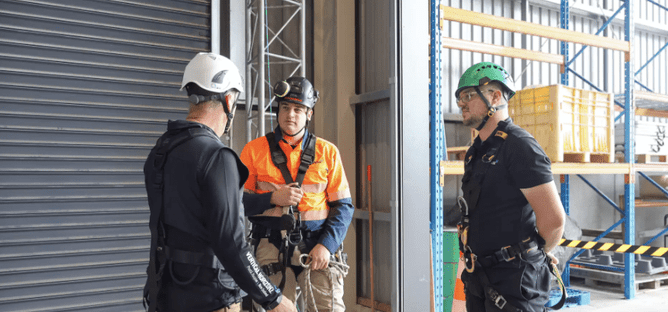Safety lessons are often presented as checklists, rules, or tidy models, yet the most meaningful insights come from practitioners who have lived through emergencies, trained thousands, and seen firsthand how people behave under pressure. In this article, based on my Health and Safety Unplugged podcast interview with Keith Barnett of Vertical Horizonz, we explore the safety lessons shaped by seventeen years of real-world experience across working at heights, confined spaces, and complex training environments in New Zealand and overseas.
"The essential safety lessons include maintaining high standards, planning for the worst, ensuring communication is clear and shared, understanding your people, preparing exit strategies before entering any hazardous environment, and never assuming training is a tick-box exercise."
Safety Lessons That Come Before Any Textbook
Safety training tends to be taught in tidy modules, but real safety is rarely tidy. Keith’s early experiences in military logistics showed him that safety begins before any formal training course. In environments where risk is constant, the first and most enduring safety lessons revolve around discipline, consistency, and situational awareness.
What is the first safety lesson most practitioners miss?
The first safety lesson many miss is that standards are non-negotiable. What you walk past becomes what you accept, and this principle influences every decision a team makes.
Textbooks teach rules. Experience teaches consequences.
Why Standards Matter – A Foundation Safety Lesson
If there is one message Keith emphasised repeatedly, it is this:
The standard you walk past is the standard you accept.
He learned this in the military, but its application across New Zealand workplaces is universal. Lower your standards once, and you reset the benchmark for everyone around you.
For trainers, leaders and auditors, this is not an abstract idea. It plays out every day on worksites, in offices and in training rooms. The safety lesson here is simple but powerful:
You cannot expect others to rise to a standard you are unwilling to hold yourself.
Safety Lessons from Military Logistics to New Zealand Workplaces
Keith’s pathway into health and safety is unconventional and deeply instructive. His early experiences in the British Army involved weapons, heat, heavy transport and high-pressure operations. Yet it wasn’t the military structure that shaped his safety philosophy, but two incidents:
A collapse from heat exhaustion, where the emergency response was inadequate.
The death of a young soldier under similar conditions, where lessons had not been applied.
These moments forged a lifelong commitment to understanding why things go wrong and how to prevent repeat failures. In his words:
“There has to be better outcomes when something goes wrong.”
This is a safety lesson that should be embedded into every training programme in New Zealand.
The Most Overlooked Safety Lesson – Planning for the Worst
Keith’s strongest message was that teams must embrace the “doomsday thinker” – the person who looks at a plan and asks:
“What if?”
Not to be negative.
Not to be difficult.
But to expose blind spots.
Communication – The Safety Lesson That Holds Everything Together
Keith highlights a principle that every PCBU and safety practitioner needs to pause and reflect on:
Information is useless unless it is shared.
It must be timely, accessible, and understood by the people who need it.
Poor communication is rarely a single-point failure. It becomes a chain:
Assumptions
Missing context
Untested plans
Confusion under pressure
This is a safety lesson many organisations relearn the hard way.
Great communication doesn’t mean more paperwork.
It means the right information, at the right time, shared in the right way.
Practical Safety Lessons for Working at Heights and Confined Spaces
Training any hazardous environment reveals the same pattern:
People want to do the job, not plan it.
Keith explains that the most valuable lessons for workers are often the ones that feel inconvenient:
Test your equipment before you arrive.
Know your anchor points.
Pre-plan your descent or rescue.
Understand how your body will behave under pressure.
Never assume a space is safe because it was safe yesterday.
The safety lesson here is consistency.
Skill helps.
Equipment helps.
But habits save lives.
Safety Lessons for Trainers, Leaders and New Practitioners
New health and safety practitioners often lean heavily on manuals and procedures. Keith understands why – it feels safer, predictable, defensible.
But he also warns of the trap:
Textbook thinking can make practitioners rigid when they need to be adaptable.
Leaders and trainers must learn to:
Adjust on the fly
Challenge assumptions
Manage different learning styles
Read people
Ask deeper questions
Create psychological safety in the room
The safety lesson is that great trainers don’t just deliver content.
They deliver clarity.
Safety Lessons That Shape People, Not Just Systems
Keith’s advice for 2025 is simple: invest in people.
Training should not be chosen based on budget or compliance pressure alone. Instead, ask:
What value will this training add to the individual?
How will it uplift the organisation?
What capability does it unlock?
What future risk does it prevent?
The worst-case question he receives from PCBUs is:
“I’ve trained this HSR - now what do I do with them?”
Training is not a cost centre.
It is an asset that compounds if you know how to use it.
The Future of Safety Lessons in NZ Training
New Zealand’s safety landscape is shifting.
Expectations are tightening.
Competency is now a strategic asset.
And organisations cannot rely on legacy practices or assumptions.
The next generation of trainers will need:
Better preparation
Better planning
Better people skills
Better feedback loops
Better adaptability
The safety lesson for the future is that technical knowledge alone is no longer enough.
Influence matters.
Engagement matters.
Cultural leadership matters just as much as legislation.
Final Safety Lessons – Keith Barnett’s Advice for 2026 and Beyond
To close our discussion, Keith offered three recommendations for every practitioner, trainer and leader:
1. Prepare properly.
Know your audience, know your objective, and know your plan.
2. Hold your standards.
Never lower them because others do. People follow what you tolerate.
3. Stay open-minded and multiskilled.
The industry rewards adaptability. The safest practitioners are the ones who can shift perspective.
These safety lessons are not theoretical.
They are lived.
Taught.
Tested.
And strengthened over nearly two decades of real experience.
Watch on Health and Safety Unplugged
If you want to hear these insights in Keith Barnett’s own words, you can watch the full interview in Episode 1 of Season 5 of Health & Safety Unplugged.
This season is designed to bring real, practical knowledge to practitioners across New Zealand.
These safety lessons set the tone for what’s ahead.
Watch on Youtube or Spotify.





